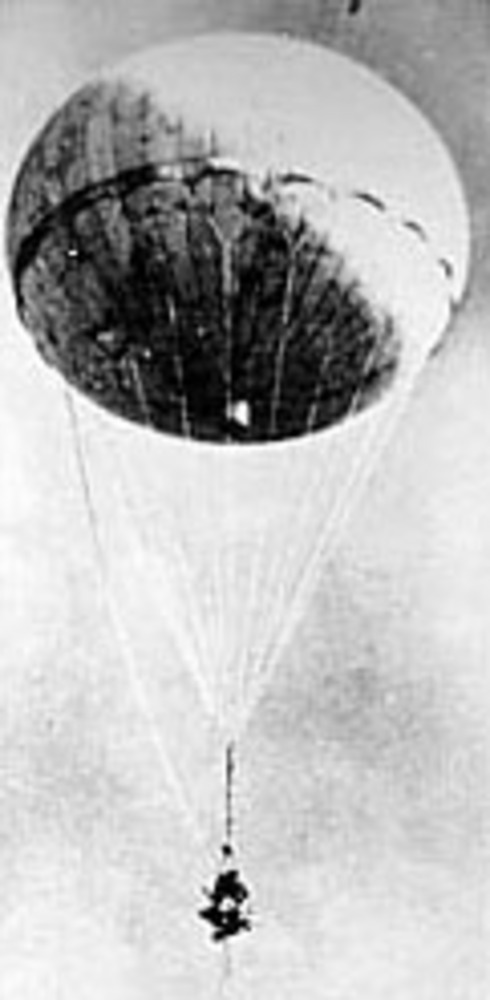The Mitchell Monument marks the spot near Bly, Oregon, where six people were killed by a Japanese balloon bomb during World War II. Designated by the National Register of Historic Places in 2003, this is the only place on the continental United States where Americans were killed by enemy action during World War II.
Between November 1944 and April 1945, Japan launched more than nine thousand balloon bombs—experimental weapons intended to kill and cause fires. The balloons, each carrying an anti-personnel bomb and two incendary bombs, took about seventy hours to cross the Pacific Ocean. Three hundred sixty-one of the balloons have been found in twenty-six states, Canada and Mexico.
The balloon bombs were 70 feet tall with a 33-foot diameter paper canopy connected to the main device by shroud lines. Balloons inflated with hydrogen followed the jet stream at an altitude of 30,000 feet. The high-explosive anti-personnel and incendiary devices were rigged to self-destruct and leave no evidence. The Japanese hoped the bombs would start forest fires and create panic, according to documents found after the war.
The first bomb was spotted southwest of San Pedro, California, on November 4, 1944. On January 4, 1945, two men working near Medford, Oregon, heard a blast, saw flames, and found a twelve-inch-deep hole in the ground where the bomb had exploded. The U.S. Office of Censorship asked the news media not to publish reports for fear it might cause panic.
On May 5, 1945, Bly minister Archie Mitchell, his pregnant wife Elsie, and five children from Mitchell's Sunday school class were on a Saturday morning picnic. Thirteen miles northeast of Bly, or about sixty miles northeast of Klamath Falls, Mitchell parked the car, and Elsie and the children headed to Leonard Creek. Mitchell later remembered: "As I got out of the car to bring the lunch, the others were not far away and called to me they had found something that looked like a balloon. I heard of Japanese balloons so I shouted a warning not to touch it. But just then there was a big explosion. I ran up there—and they were all dead."
The explosion created a foot deep, 3-foot-wide hole. Bomb fragments were found 400 feet from the explosion site. Six people died: Elsie Mitchell, 26; Dick Patzke, 14; Jay Gifford, 13; Edward Engen, 13; Joan Patzke, 13; and Sherman Shoemaker, 11.
A front-page story in the May 7, 1945, Klamath Falls Herald and News provided no details and reported only that the six were killed "by an explosion of unannounced cause." The U.S. government did not warn of balloon bomb dangers until a week later. Officials released limited information about balloon bombs on May 22 and on June 1 lifted the blackout on the explosion's cause.
The National Register nomination form states: "This particular event and site are the most recognized representation of the use of a Japanese strategic weapon against the United States during a major global war and documents the first use of an intercontinental ballistic weapon in history."
When the stone monument was dedicated on August 20, 1950, Oregon Governor Douglas McKay said the members of the Mitchell family were casualties "just as surely as if they had been in uniform."
-
![]()
Japanese balloon bomb in flight.
U.S. Air Force photo
-
![Gun camera photo sequence of Japanese balloon bomb being shot down in the Aleutian Islands, April 1945.]()
Japanese balloon bomb being shot down.
Gun camera photo sequence of Japanese balloon bomb being shot down in the Aleutian Islands, April 1945. U.S. Air Force photo
-
![]()
Japanese balloon bomb display at the National Museum of the U.S. Air Force, Dayton, Ohio.
Photo by M. K. Sheppard, 2008
-
![Vicki Wiese of the Coos Historical & Maritime Museum holds part of a Japanese balloon bomb.]()
Coos Historical Museum.
Vicki Wiese of the Coos Historical & Maritime Museum holds part of a Japanese balloon bomb. Courtesy of The World newspaper, photo by Lou Sennick
Related Historical Records
Map This on the Oregon History WayFinder
The Oregon History Wayfinder is an interactive map that identifies significant places, people, and events in Oregon history.
Further Reading
"Blast Kills 6, Five Children, Pastor's Wife in Explosion: Fishing Jaunt Proves Fatal to Bly Residents," Klamath Falls Herald and News, 7 May 1945, page 1.
Juillerat, Lee. "Mitchell Monument: A Place Remembered." Service & Sacrifice: Klamath Basin Life Through Two World Wars (Journal of the Shaw Historical Library, Vol. 17), 2003.
Sol, Ilana. On Paper Wings. Film. Portland, Ore.: Ilana Sol, 2008.
Radiolab Podcast, Fu-Go. March 10, 2015. http://www.radiolab.org/story/fu-go/




